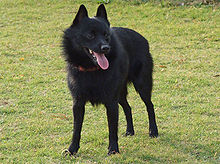Schipperke
 |
||||||||||||||||||||||||||
| Common nicknames | Spitzke (until 1888) Spits (until 1888) Spitske (until 1888) |
|||||||||||||||||||||||||
|---|---|---|---|---|---|---|---|---|---|---|---|---|---|---|---|---|---|---|---|---|---|---|---|---|---|---|
| Origin | Belgium | |||||||||||||||||||||||||
|
||||||||||||||||||||||||||
|
||||||||||||||||||||||||||
| Domestic dog (Canis lupus familiaris) | ||||||||||||||||||||||||||
| Traits | |||
|---|---|---|---|
| Weight | 3–9 kg (6.6–19.8 lb) | ||
| Height | Male | 33.6 cm (13.2 in) average | |
| Female | 31.2 cm (12.3 in) average | ||
| Color | any solid color | ||
| Life span | 13–15 yrs | ||
| Classification / standards | |||
|---|---|---|---|
| FCI | Group 1, Section 1 Sheepdogs #083 | standard | |
| AKC | Non-sporting | standard | |
| ANKC | Group 7 (Non-sporting) | standard | |
| CKC | Group 6 (Non-sporting) | standard | |
| KC (UK) | Utility | standard | |
| NZKC | Non-sporting | standard | |
| UKC | Companion Breeds | standard | |
A Schipperke (/ˈskɪpərkiː/; Dutch: [ˈsxɪpərkə]) is a small Belgian breed of dog that originated in the early 16th century. There has been a long informal debate over whether this type of dog is a spitz or miniature sheepdog. In their home country of Belgium they are considered a small shepherd.
Their small, pointed ears are erect atop the head. Schipperkes are double coated with a soft, fluffy undercoat that is covered by a harsher-feeling and longer outer coat. One of the breed characteristics is a long ruff that surrounds the neck and then a strip trails down towards the rear of the dog. They also have longer fur on their hind legs called culottes. The breed is black, or blonde (some blondes have a silkier coat), and the coat is shiny.
Dogs of this breed usually weigh 3–9 kg (7–20 lbs). Puppies are born with tails in different lengths. In Canada and the United States, the tail is usually docked the day after birth. In countries that have bans on docking, Schipperkes display their natural tails, which vary in type.
Known for a stubborn, mischievous, and headstrong temperament, it also chases small animals. The Schipperke is sometimes referred to as the "little black fox", the "Tasmanian black devil", or the "little black devil". They are naturally curious and high-energy dogs and require ample exercise and supervision. Schipperkes are very smart and independent; and sometimes debate listening to owners, instead choosing to do whatever benefits them the most, and are not necessarily the proper dog for a first-time dog owner. Schipperkes require training and a secure, fenced-in space to run. They are formidable barkers and can be aggressive with other dogs. Otherwise they are overall good dogs, and their personality is a matter of how they are raised, and who they are around. They often have a high prey drive, focusing on rodents and small animals, and can excel at obedience and agility competitions.
...
Wikipedia
